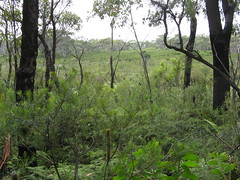Here is some (slightly old) news about an incredible win for Rivers SOS:
On Wed. Oct. 27 we received the amazing news that BHP had withdrawn from its current Bulli Seam Operations Project the 5 contentious eastern domains which included the Dharawal State Conservation Area, drinking water catchments of the Woronora and Cataract Rivers and all 226 upland swamps within the application area. BHP are claiming that they did this in response to community concerns but what really happened was that the Planning and Assessment Commission (PAC) Report which was made public that day was so utterly damning of BHP’s Environmental Assessment that they realised they had no chance of obtaining approval for these areas.
Some excerpts from the PAC Report:
The Panel is of the view that it is no longer a viable proposition for mining to cause more than negligible damage to pristine or near-pristine waterways in drinking water catchments or where these waterways are elements of significant conservation areas or significant river systems.
This level of damage would not be acceptable in any other assessment of water resource use.
The analysis reported in Chapter 17 shows that the benefits of protecting significant natural features in the eastern and southern areas are likely to be of a similar magnitude to the mining profits that would have to be given up to ensure that protection. So while protection of the significant natural features would involve lower mine profitability, it is likely that society as a whole would gain more from the environmental protection recommended than it would lose in terms of foregone profits.
(Is this a first?)
Remediation is a frequently proposed strategy in the EA for managing risks of subsidence induced impacts and consequences for significant natural features and built infrastructure. For significant natural features that are water-dependent, the Panel made a number of specific findings and conclusions. These can be summarized as demonstrating that remediation cannot be considered at this time to be an alternative to prevention where the functionality of water-dependent natural features is an objective.
The PAC report can be found at: http://majorprojects.planning.nsw.gov.au/files/62364/PAC%20Report.pdf
BHP are saying they intend to seek approval to mine these areas in the future when they can prove they can do it without causing unacceptable damage. We hope that we can prevent this by achieving National Park status for the Dharawal SCA and that campaign is already under way.
The Project was referred to the Federal Govt. for assessment under the EPBC Act due to threatened species. Although much of this threat is now gone, issues still remain with the contentious coalwash emplacement area in Brennan’s Ck valley. An EIS is to go on public exhibition in November 2010.
Part of building a case for National Park status for the Dharawal SCA is possible RAMSAR listing of the area’s upland swamps. Also in train is a process to reclassify the swamps as Temperate Highland Peat Swamps on Sandstone which is an EEC under Federal legislation.
Below are photos of Swamp, which have been saved from destruction.
The Dharawal National Park campaign is the logical next step to permanently protect the headwaters of the Georges River which are encompassed by the Dharawal SCA. The difficulty will be to achieve the relinquishing of the existing mining leases held by BHP. A coalition of groups, including NPA’s Southern Sydney and Macarthur Branches is already working on this campaign.
This map shows the areas withdrawn from the original plan.



